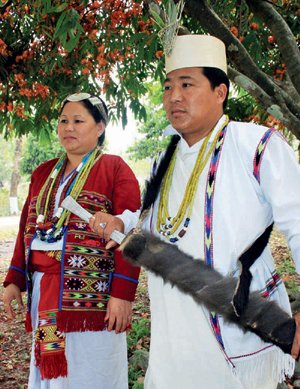Bhalukpong is a small town located along the southern reaches of the Himalayas in West Kameng district of Arunachal Pradesh in India. The town is located at 213m above sea level, 100 km from Bomdila, 52 km from Tezpur and 5 km from Tipi. It lies along the Kameng river and is the headquarters of Bhalukpong circle. A road leads to Bomdila via the Tipi Orchidariurm, and the inner line check post is located at Bhalukpong.
Bhalukpong lies on the banks of the mighty Kameng river and borders along the dense forests that form the periphery of the Pakhui Game Sanctuary. Bhalukpong is a gateway to popular destinations like Tawang and Bomdila, but it has its own special charm too. It is a favorite picnic spot and people from nearby areas of Assam and Arunachal Pradesh congregate here every year in hordes to emjoy picnics. Fish angling and river rafting are the other principal tourist activities in Bhalukpong. Tourist attractions in Bhalukpong include the Pakhui Game Sanctuary and Tipi Orchidariurm, which hosts over 2600 cultivated orchids from 80 different species.
Bhalukpong Fort was constructed round tenth century and although now in ruins, it stands for the tradition and historical glory of the place. It was constructed by king Bhaluka on the banks of Bharali River. Apart from the fort’s stays, necessary stays of Bana, grandson of King Bhaluka are additionally preserved right here. The remains of the fort located on the banks of River Bharali, have a few stone blocks and bricks on the slope of the hillock. A pond and a brick well are also found here. Historical remains of Bana, the grandson of King Bhaluka and the heroic character of Mahabharata are also found here.
The annual festival Nyethidow of the Aka tribe is celebrated in January at Bhalukpong,Thrizino . Bhalukpong is inhabited by members of the Aka Tribes.
Bhalukpong Essentials
AKA CULTURE
The Aka, also known as Hrusso, are found in the Thrizino (cultural hub), Bhalukpong (commercial hub), Buragaon, Jamiri, Palizi, Khuppi area in West Kameng of the Indian state of Arunachal Pradesh.
The Aka share strong cultural affinities with the Miji, and intermarriage with the Miji is prevalent Centuries of Vaishnava and intermittent Tibetan influence from the Sherdukpen has shaped the Aka culture into its modern form. Handicrafts, basket weaving and wood carving are the principal arts among the Aka tribe. One of the most notable features of Aka arts is the Chinese design of the Jana flower, which can be often found on many of the indigenous haversacks. It is a known legend that the Jana flower represents the commemorate an ancient Tibetan king, who was believed to have led his entire life through daily reincarnations. It was also believed that he lived in an open giant palace that grew the Jana flowers every time the sun sets.


